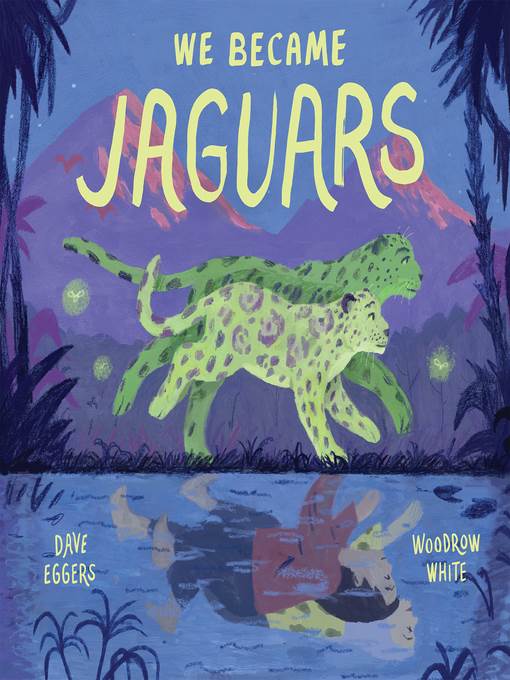
We Became Jaguars
کتاب های مرتبط
- اطلاعات
- نقد و بررسی
- دیدگاه کاربران
نقد و بررسی

December 4, 2020
K-Gr 2-A young boy is visited by his grandmother. When she suggests they be jaguars, the boy gives her his best jaguar impersonation: crawling on all fours, as elegantly as possible. The boy and his grandmother scurry around the living room and suddenly find themselves in a lush jungle. For the remainder of the book, they are portrayed as sleek jungle cats. Is this real, or in their imagination? Eggers not only transmogrifies his characters into jaguars, he also uses the word "jaguar" as both noun and verb with the repeated refrain: "We jaguared on." This playfulness isn't restricted to language. White's illustrations are spirited and clever. The surreal transformation from human to jaguar is sumptuously depicted on a stunning gatefold. Later, when the jaguars drink from a cool stream, their human faces appear in the water's rippled surface. White's color palette is beautiful. The two explore the world from evening to daylight to sunset. At night, the jaguars glow green in the midst of the dark jungle, purple like a velvet painting. In the mountains, their fur reflects the warmth of the setting sun. Eventually the child must return to the real world. School awaits. He leaves a realm of imagination that is so fantastic it feels real, or so real that it feels fantastic? VERDICT A must-have tale about the power of imagination.-Chance Lee Joyner, Haverhill P.L., MA
Copyright 2020 School Library Journal, LLC Used with permission.

Starred review from January 11, 2021
From the minute the child narrator’s slim, stylish grandmother arrives for a visit (“Her hair was very white/ and very, very long”) and his parents leave, she’s ready for some serious make believe. “Let’s be jaguars,” she says, growling on all fours on the rug. The boy tries to follow suit: “No, leaner,” she tells him. “Now faster.” In spreads by artist White, making his picture book debut, the two morph into real jaguars, sprinting gracefully through the woods and to lands beyond. The child is simultaneously cowed and enthralled by the grandmother’s wildness. When she offers a rabbit that she’s just killed, “I didn’t want to eat raw rabbit so I said I was allergic.” When he expresses doubt that they can run across a lake, she counsels perfect confidence, and she’s right: “We bounced across like marbles on glass.” Working in milky shades, White succeeds in making the duo readable in the faces and bodies of the two cats. The vivid concept that a grandmother’s visit delivers danger and freedom instead of cozy reassurance is a winner, and Eggers (Most of the Better Natural Things in the World) develops it with easy humor and jaguar-speed pacing. Ages 5–8. Author’s agent: Steven Malk, Writers House.

February 1, 2021
Preschool-Grade 2 A little boy is shy at first when his parents leave him with his visiting grandmother. But he becomes bolder when she gets down on the carpet, growls, and says they should become jaguars. The little boy follows her instructions and, presto, the transformation is complete and the wild rumpus begins. Leaving the house, they come to a nearby wood, which become jungle-like when they enter. On the other side, they come to a steep hill and easily run to the top, where they can see "most of the world." They drink from a lake, and then, "somewhere in the Himalayas," the boy remembers he has to go to school. Who knows how much he has missed? But it's okay; his now-human grandmother writes him a note. Eggers' straightforward text is enlivened by simile: a lake looks like silver and tastes like moonlight and is further enhanced by White's lushly colorful illustrations. But do the two humans really become jaguars? Careful readers will find visual clues but no matter; what's really important is the book's lively celebration of imagination.
COPYRIGHT(2021) Booklist, ALL RIGHTS RESERVED.

Starred review from February 1, 2021
Left alone together, a small child and their grandmother transform into jaguars, walking on all fours on the carpet and then out into the night. The grandmother, with her "very, very long" white hair, dark brows, crimson nails, and spotted cardigan, appears game for anything wild. The child has met her only once, and her bold demeanor will intrigue children used to benign literary grandmothers who dole out cookies and cuddles. This grandmother directs the child to look "leaner" and "fiercer" as they make the shape of a jaguar on the floor alongside her. "Now we go," she states flatly. A clever gatefold shows the pair's metamorphosis from white-skinned humans to furry felines stalking through night grasses. Transfixing painterly illustrations offer nocturnal purples and blues along with bioluminescent pinks and greens, creating a woozy, otherworldly habitat. The little jaguar seems a bit scared at first, tremulous, turning down raw rabbit by claiming an allergy. Young people will find humor in the child's narration, perhaps especially when they relate that "we were somewhere in the Himalayas when I remembered that I had school." The phrase "we jaguared on" repeats again and again as they cross varying landscapes, and it perfectly captures the fluidity of jaguar movement in its languid articulation. Children will relish this book's blurred ambiguities; what's real and what's imagined are as hard to distinguish as a jaguar in the shadows. A fresh inversion of expectations told in vivid art and idiom. (Picture book. 4-8)
COPYRIGHT(2021) Kirkus Reviews, ALL RIGHTS RESERVED.

























دیدگاه کاربران